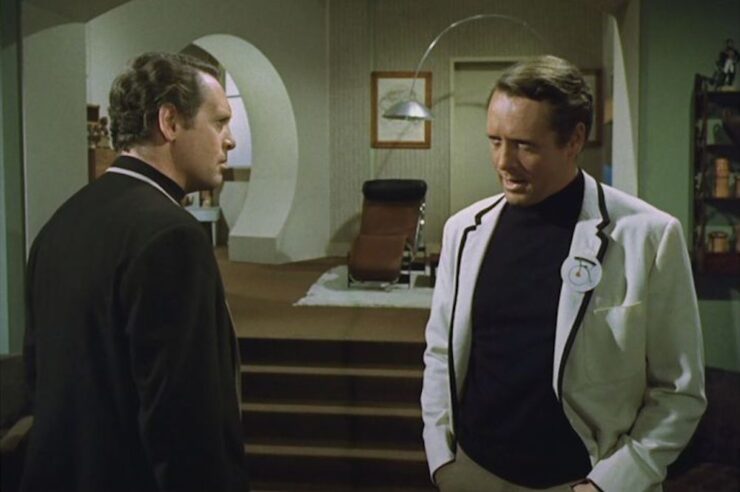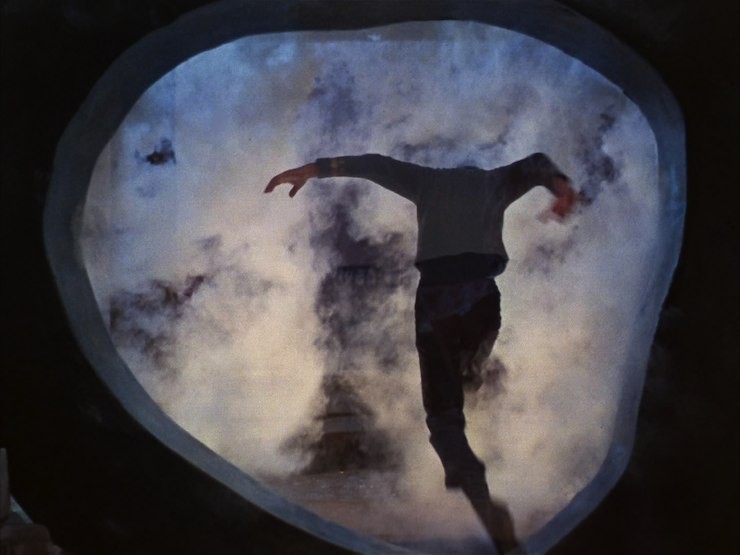“If I’m not me, who am I? And If I’m somebody else, why do I look like me?” —Popeye, “Hello, How Am I?”
An interesting thought came to me while prepping for this piece: In the past forty years, has anyone on Earth had reason to utter the phrase, “Three wavy lines?”
Might not mean anything to you, especially if you were born after 1980. But yeah, in the ’60s and ’70s, that phrase had carved out a little niche for itself in pop culture. It referred to one of the five Zener cards, a tool—invented by, duh, Dr. Karl Zener—meant to test a person’s ability to read minds. The idea was that the researcher would shuffle a deck of these cards, go through them one by one—the cards’ other symbols were a circle, a square, a cross, and a star—and the test subject would try to divine which symbol the researcher was looking at. (Why four-fifths of the cards could be identified by monosyllables while the fifth was a complex, very precise descriptor, I haven’t been able discover. Maybe it was a bonus round—like, if you guessed that one, you got a free sandwich.)
The process was eventually debunked—turns out there were ways to beat the system, either deliberately or inadvertently—and the last I personally saw of the things was a cameo at the beginning of Ghostbusters (1984) where they were used as a metaphor for how disreputable paranormal research had become. For a while, though, the Zener cards were the gold standard if a film or TV show needed a shorthand way to demonstrate a person’s psychic capacity. The symbols were easy for the camera to read at a distance, unlike standard playing cards, and the process was straightforward enough that audiences needed no explanation to understand what was going on. The technique was so well-accepted that when, at the beginning of “The Schizoid Man”—the fifth episode of the 1967 British TV series The Prisoner—we see the show’s protagonist, Number 6 (Patrick McGoohan), running fellow prisoner Number 24 (Jane Merrow) successfully through the drill, it means something that the otherwise chronically skeptical Number 6 treats her acing the test as irrefutable proof of her psychic abilities.
Well, whaddya want? It was the Sixties, when paranormal research still kinda looked like a credible science. But then, The Prisoner overall was a good example of the culture at the time, and in particular of a kind of satiric storytelling that we’ve since lost, something at once wild, biting, and yet sincere. I’m not one to harp on the “They don’t make them like they used to” schtick—art evolves, and what gets left behind by-and-large doesn’t automatically vanish—but I do miss that particular brand of caustic wit. It still crops up every now and then—a Wag the Dog here, a Bamboozled there, a Don’t Look Up elsewhere (much as I didn’t like the latter)—but things like The President’s Analyst, The Ruling Class, and Dr. Strangelove or: How I Learned to Stop Worrying and Love the Bomb channeled an intensely earnest kind of rage that got shuffled off the stage once some refugees from The Harvard Lampoon joined forces with the comedic talents of Canada to form a more detached and ironic kind of humor.
Before that particular tide turned, though, we got The Prisoner. A follow-up to McGoohan’s previous show, Danger Man (known as Secret Agent here across the pond), The Prisoner was built around a simple but intriguing premise: A spy (presumably Danger Man’s John Drake, although the show never admits to that outright), having resigned his commission with no little righteous indignation, is abducted by forces unknown and whisked away to a facility where he can be interrogated.
Beyond the basic premise, though, there’s very little that’s simple or straightforward. The “prison” is the Village, an ice-cream-colored fantasy community secreted somewhere in Europe, although where exactly varies from episode to episode—in the show’s finale, it’s even suggested it’s located about a five-hour drive outside of London. There are cameras everywhere—including, of course, in the cottage-like residences—the inhabitants may be fellow agents or moles working for the warders, and despite the resort-like amenities (the show’s outdoor sequences were shot on-location in the actual Welsh resort village of Portmeirion), behind the scenes there operated an apparatus of psychological manipulation and torture. All of the Villagers (almost—more on that later) are assigned numbers, all the better to break their spirits: The person in charge, portrayed by guest actors rotated out on a week-by-week basis, is Number 2; the ultimate authority is a mysterious Number 1; and McGoohan’s otherwise nameless character is dubbed Number 6.
It isn’t hard to recognize the anxiety of the Sixties poking its head into the basic scenario—computerized archiving of information was becoming more prevalent; telephone companies were dropping their quaint locators of Melrose-5 and Lexington-8 in favor of flavorless all-digit dialing. It didn’t stop there. Using the framework of one man pitted against a system determined to dehumanize him at every step, producers McGoohan and David Tomblin allowed the series to morph into whatever format they needed to take the piss out of a tumultuous time. There’d be political satire and paranoid thriller; one episode sent up the campy mess the James Bond films had become; another was a flat-out spaghetti western.
And there was existential angst. Lots of it, to the point where the narratives could become downright surreal. “A Change of Mind,” anticipated Kubrick’s A Clockwork Orange (1971) in a scenario where Number Six undergoes a procedure to check his antisocial behavior. “Dance of the Dead” begins with Number 6 finding a radio that tuned into the outside world, which eventually leads to him being tried and sentenced to death by a kangaroo court of costumed revelers, and ends with him trashing a teletype machine that clatters back to life as Number Two informs him that the zeal of his would-be executioners is misplaced, because he’s already dead.
And then there was “The Schizoid Man.”
Many episodes of The Prisoner revolved around the week’s Number 2 deploying elaborate mind-fucks—to use a clinical term—to find out why Number 6 resigned. (There were also many episodes focused on Number 6’s efforts to escape the Village, and it was not uncommon for the two plots to intersect, as they do here.) In “The Schizoid Man,” the plan is to have Number 6 question his own identity by introducing him to his doppelgänger. This was not an unusual trope for the time—such stories usually ended with a fistfight between the look-alikes while a gun-wielding spectator declared, “But which one should I shoot?” (This eventually morphed into the present-day trope of a clone and its creator arguing over which one was the original.) But McGoohan and writer Terence Feely worked a wicked little variation on the theme, first having Number 6 spirited away in the middle of the night to undergo weeks of reprogramming, and then having him reinserted into the Village as the imposter, Number 12. He wakes up left-handed, with lacquered, black hair, and a similarly cheesy mustache. Villagers greet him by his new number, and Number 2 (Anton Rodgers) effuses over their longtime friendship and his delight that his compatriot has been assigned the task of breaking Number 6. When Number 6 protests that he’s the real thing, Number 2 blithely compliments him on staying committed to his role. (You see? Some UK actors besides Daniel Day Lewis do use the Method).
The true mind games begin once Number 12 meets “Number 6” (also played by McGoohan—director Pat Jackson does some neat stuff with split-screen, doubles, and camera moves to make it look like the two entities are sharing the same scene). In portraying the imposter, McGoohan drops his character’s customary stoic determination in favor of a hyped-up parody, making him archly flippant, almost jolly. His voice is pitched up an octave, he smirks, he snarks, he exudes an easy confidence. He’s the flesh-and-blood equivalent of what people go through when they first behold themselves on video: The image is immediately recognizable, and yet uncannily wrong.
Doubly galling is that he turns out to be a better Number 6 than Number 6. He can handle objects with his right hand without fumbling, bests his rival at fencing and boxing, and has the identifying mole that somehow has vanished from the real Number 6’s arm. (Driving another nail in the coffin, Number 2 summons the doctor meant to replicate the blemish and upbraids him right in front of Number 12.) The coup de grace comes when the real Number 6 attempts to run through the Zener cards with Number 24 (whom Number 6 calls by name, in what appears to be a deliberate break in protocol by the show’s creators), and fails miserably, while his double crushes the test.
There’s an exquisitely insidious tang to the way Feely manages to continually pull the rug out from under Number 6’s feet, not just undermining his attempts to prove his legitimacy, but having Number 2 frequently pipe in with a, “It’s all right, old chap, not your fault we didn’t prep you sufficiently.” Little by little, but with impressive speed (the show only runs an hour, after all), the former spy’s sense of self is stripped away. Before the plot turns back in his favor—the discovery of a bruise inflicted before the reprogramming triggers Number 6’s suspicions, and bit of do-it-yourself shock therapy restores his right-handedness—we see him convulsing in bed, wracked with doubts about his own identity.
Well, who could blame him? A lot of the audience may well have identified, what with the nagging sense that, more and more, the System—however you cared to define it—was seeking to strip away our individuality. But “schizoid,” after all, refers to an internal fracture, one that predates computers and prosperity-induced conformity. There’s a fragility to the ways we benchmark our own identities; it can be short-circuited by those who know just the right buttons to push. Number 6 above all has managed to survive the mind games of the Village by maintaining a rock-solid confidence in who he is. To have that subverted through an encounter with a cartoonish satire of himself is to trigger a kind-of inverse version of the imposter syndrome: What if you’re not just committing a fraud on others, but a fraud on yourself?
But given The Prisoner’spenchant for allegory, am I too out-of-line in thinking the creators were looking at a broader crisis of identity? It was a turbulent time: Unpopular wars, the struggle for civil rights, the conflict between capitalism and socialism—plus the questioning within a once-dominant world power of what follows once the Empire crumbles—were causing a serious reappraisal of what the world had become. Were we the heroes we believed ourselves to be, or were we fooling ourselves? If you looked in the mirror and didn’t recognize the face that looked back, could there be a good reason?
“The Schizoid Man” doesn’t go quite as wide-ranging when it comes to resolving the conflict. Number 6, being Number 6, regains his sense of self through sheer will, while the doppelgänger is killed by a malfunctioning security robot for his hubris. Number 6 even reaffirms his psychic connection with Number 24 while impersonating Number 12 in a thwarted attempt at escape. (BTW: Number 6, Number 12, Number 24? Doubles all over the damn place!) Maybe the intent was just to encourage us to be secure in ourselves, despite those who endeavored to manipulate us. Know thyself, and fuck anyone who tells you different.
I’ll admit I may be taking it too far in reading a broader social critique into “The Schizoid Man.” But The Prisoner came at a time when social commentary could wear its heart on its sleeve, when fury at the state—as well as the state of things—could be voiced at top volume. McGoohan and his team weren’t afraid of taking wild swings at their targets—to the point where some of the show’s narratives were not only perplexing upon their debut, but remain so today. The series sometimes ran the risk of having its viewers throw up their hands and shout, “Okay, okay, I get it!” but that brash earnestness was, more often than not, exhilarating. (By contrast, when AMC offered a remake of the series in 2009, the attempt to tame the narrative into some form of coherence, combined with a presentation that leaned more into Lynchian enigma, robbed the tale of the energy that made it so compelling.)
Whatever its intent, The Prisoner was visionary filmmaking, and “The Schizoid Man” was a warped little inquest into the question of identity. Like Number 6 confronting his double, it made us ask who we truly are, and whether we like what we see.
* * *
It’s becoming popular—maybe too popular—for media commentators to go around declaring: “You couldn’t make that show today.” All in the Family is frequently dragged into that argument, but I suspect some would want to cite The Prisoner as well, not so much for its controversial subject matter as for its attitude. It does seem very much of its time, when a societal revolution was at hand and we could be more upfront with our passions. But have we become so jaded as a culture that—AMC botch notwithstanding—somebody couldn’t take another stab at The Prisoner, or its equivalent, and imbue it with the kind of zeal that crackles through the original? What do you think? Is The Prisoner just an archaic artifact of its time, or something that still has value today? Are there any contemporaries fit to join its rank in wit, incisiveness, and style? If you have thoughts, you’re welcome to comment below. Remember to be friendly and polite with your contributions—you are being monitored!












